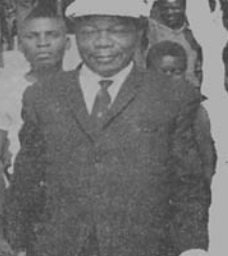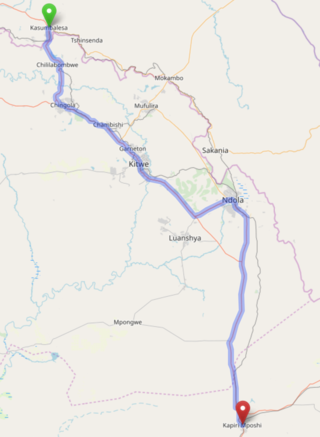Related Research Articles

Northern Rhodesia was a British protectorate in Southern Africa, now the independent country of Zambia. It was formed in 1911 by amalgamating the two earlier protectorates of Barotziland-North-Western Rhodesia and North-Eastern Rhodesia. It was initially administered, as were the two earlier protectorates, by the British South Africa Company (BSAC), a chartered company, on behalf of the British Government. From 1924, it was administered by the British Government as a protectorate, under similar conditions to other British-administered protectorates, and the special provisions required when it was administered by BSAC were terminated.

Ndola is the third largest city in Zambia in terms of size and population, with a population of 475,194, after the capital, Lusaka, and Kitwe, and the second largest in terms of infrastructure development after Lusaka. It is the industrial and commercial center of the Copperbelt, Zambia's copper-mining region, and capital of Copperbelt Province. It lies just 10 kilometres (6.2 mi) from the border with DR Congo. It is also home to Zambia's first modern stadium, the Levy Mwanawasa Stadium.

Kitwe is the third largest city in terms of infrastructure development and second largest city in terms of size and population in Zambia. With a population of 517,543 Kitwe is one of the most developed commercial and industrial areas in the nation, alongside Ndola and Lusaka. It has a complex of mines on its north-western and western edges.

Zambia Railways (ZR) is the national railway company of Zambia, one of the two major railway organisations in Zambia. The other system is the binational TAZARA Railway (TAZARA) that interconnects with the ZR at Kapiri Mposhi and provides a link to the Tanzanian port of Dar es Salaam.

The Walvis Bay-Ndola-Lubumbashi Development Road, formerly known as the Trans-Caprivi Corridor and until 2004 the Trans-Caprivi Highway, begins in Walvis Bay. It runs through Rundu in northeastern Namibia and along the Caprivi Strip to Katima Mulilo on the Zambezi River, which forms the border between Namibia and Zambia. The Katima Mulilo Bridge spans the river to the Zambian town of Sesheke. From there, the road continues as the M10 Road to Livingstone, where it connects to the main north–south highway to Lusaka and extends to the Copperbelt.
A major strike broke out among African mineworkers in the Copperbelt Province of Northern Rhodesia on 29 May 1935 in protest against taxes levied by the British colonial administration. The strike involved three of the province's four major copper mines: those in Mufulira, Nkana and Roan Antelope. Near the latter, six protesters were killed by police and the strike ended. Although it failed, the strike was the first organized industrial agitation in Northern Rhodesia and is viewed by some as the first overt action against colonial rule. It caught the attention of a number of African townsmen, leading to the creation of trade unions and African nationalist politics, and is seen as the birth of African nationalism.

Harry Mwaanga Nkumbula was a Zambian nationalist leader involved in the movement for the independence of Northern Rhodesia, as Zambia was known until the end of British rule in 1964. He was born in the village of Maala in the Namwala district of Zambia's southern province. He was the youngest of three children and the only son.

The following outline is provided as an overview of and topical guide to Zambia:
Zambia, officially known as the Republic of Zambia, is a landlocked country in Southern Africa. The neighbouring countries are the Democratic Republic of the Congo to the north, Tanzania to the north-east, Malawi to the east, Mozambique, Zimbabwe, Botswana, and Namibia to the south, and Angola to the west. The capital city is Lusaka, located in the southeast of the country. The population is concentrated mainly around the capital and the Copperbelt to the northwest.

The Livingstone Museum, formerly the David Livingstone Memorial Museum and after that, the Rhodes-Livingstone Museum, is the largest and the oldest museum in Zambia, located in Livingstone near Victoria Falls. The museum has exhibits of artifacts related to local history and prehistory, including photographs and musical instruments, and also holds possessions and memorabilia - including letters and journals - of David Livingstone, the explorer and missionary.
Rugby union in Zambia is a minor but growing sport. The Zambia national rugby union team is currently ranked 67th by World Rugby. The Zambia Rugby Football Union has 9880 registered players and three formally organised clubs.

Lusaka is the capital and largest city of Zambia. It is one of the fastest-developing cities in southern Africa. Lusaka is in the southern part of the central plateau at an elevation of about 1,279 metres (4,196 ft). As of 2019, the city's population was about 3.3 million, while the urban population is estimated at 2.5 million in 2018. Lusaka is the centre of both commerce and government in Zambia and connects to the country's four main highways heading north, south, east, and west. English is the official language of the city administration, while Bemba and Nyanja are the commonly spoken street languages.
David Phiri was a Zambian businessman who was a former Governor of the Central Bank of Zambia. He was also Chairman of the Football Association of Zambia.
Harry Wulfsohn was a partner in Susman Brothers & Wulfsohn. He was born on 10 March 1911 at Frauenburg, what was then the Russian Courland Governorate, now part of Latvia. In 1929, when he was eighteen years old, Harry's aunt invited him to travel to South Africa with his sister Marlie. Harry worked for some time in the bar of his aunt's hotel, but did not stay long in South Africa. By 1930, he had followed Marlie to Ndola, in the copper belt of Northern Rhodesia, where his sister married Abe Lowenithal, to whom she had been engaged before she left Latvia. However, Marlie died three years later. Her younger sister Hessie, who also followed her to Africa, become Abe's second wife in 1934.
Bwana Mkubwa is a settlement and a mine in Copperbelt Province, Zambia. It is the oldest mine in Zambia's Copperbelt region. As a settlement with no municipal status, it became a locale due to the abundant copper deposits found in the area. Today, it is part of Ndola.
Elie Susman (1880-1957) was the founder of Susman Brothers, an African business partnership. He was a director of approximately 50 companies and chairman of the Rhodesian Mercantile Holding Co.

The history of the Jews in Zambia goes back to the early 1900s. Jews were always a small community with a notable role in Zambian history. The history of the Jews in Zambia dates to 1901 when it was still under British Colonial rule. Northern Rhodesia was colonized in the 1890s by the British South Africa Company, otherwise known as BSAC. Initially, Northern Rhodesia was split into North-eastern and North-western Rhodesia. However, the BSAC united them in 1911 to form Northern Rhodesia, which has its capital in Livingstone, near Victoria Falls. Among the population of 1 million people, there were 1,500 white residents in Northern Rhodesia, of whom many were the Jewish settlers. Northern Rhodesia became under British Colonial Rule partially so that the British Government could increase the number of white individuals and settlers in the country, which would contribute to a wider strategy to increase the influence that the British has between Kenya and South Africa. The Jewish settlers were one of the dominant ethnic groups and became highly involved in local politics, with prominent Jewish figures driving the push for Zambian independence and African nationalist rhetoric. Northern Rhodesia’s fertile land, World War II, and independence from the British Colonial rule all had a profound impact on both immigration and emigration of Jewish refugees. The Jewish diaspora introduced trade and commerce into the region in both regional and urban areas through cattle trading, ranching, mining, communication networks, storefronts, transport, and butchery, amongst others. The Jewish settlers, whether they are Jewish through origin, birth, marriage, or confession, all formed a small, yet strong community. The Jews in Zambia were a Jewish diaspora cultural and religious settler minority group, which raises concerns about the notion of who is the coloniser, who is the colonised, who is the victim and who is the oppressor. This deems that it can be studied through a postcolonial framework. Following Zambia's independence in 1964, there was a large exodus of Jews and white individuals from the country. In 2022, there remains less than fifty Jews in Zambia.After existence for 130 years as of 15 June 2024 the total of Jews in Zambia numbers 11

A komboni is a type of informal housing compound or shanty town common to Zambia, particularly the capital city of Lusaka. It is characterized by a low income and a high population density. Kombonis typically began as housing for employees of a particular company, estate, or mine. An estimated 35% of Zambians live in urban areas, and kombonis exist in many of them. It is estimated that 80% of the population of Lusaka live and work in these areas.
Chambishi is a town in Kalulushi District in the Copperbelt Province of Zambia. According to the 2021 Census its population stands at slightly above 11,000. It is located on the T3 road between the cities of Kitwe and Chingola.

The T3 is a trunk road in Zambia. The road runs from Kapiri Mposhi via Ndola, Kitwe and Chingola to Kasumbalesa on the border with DR Congo. The entire route is a toll road.
References
- ↑ Vickery, Kenneth Powers (1986). Black and White in southern Zambia: the Tonga Plateau economy and British imperialism, 1890-1939. Greenwood Publishing Group. pp. 83–. ISBN 978-0-313-25106-1 . Retrieved 5 July 2011.
- ↑ Susman, David (1 January 2004). An African shopkeeper: memoirs of David Susman. Fernwood Press. ISBN 978-1-874950-78-3 . Retrieved 5 July 2011.
- 1 2 3 4 "The First Mayor Of Kitwe – 1954". Kitwe On Line. April 20, 2011. Retrieved 5 July 2011.
- ↑ Macmillan, Hugh (2005). An African trading empire: the story of Susman Brothers & Wulfsohn, 1901-2005. I.B.Tauris. pp. 1–. ISBN 978-1-85043-853-3 . Retrieved 4 July 2011.
- ↑ McIntyre, Chris (13 April 2010). Botswana: Okavango Delta, Chobe, Northern Kalahari . Bradt Travel Guides. pp. 455–. ISBN 978-1-84162-308-5 . Retrieved 5 July 2011.